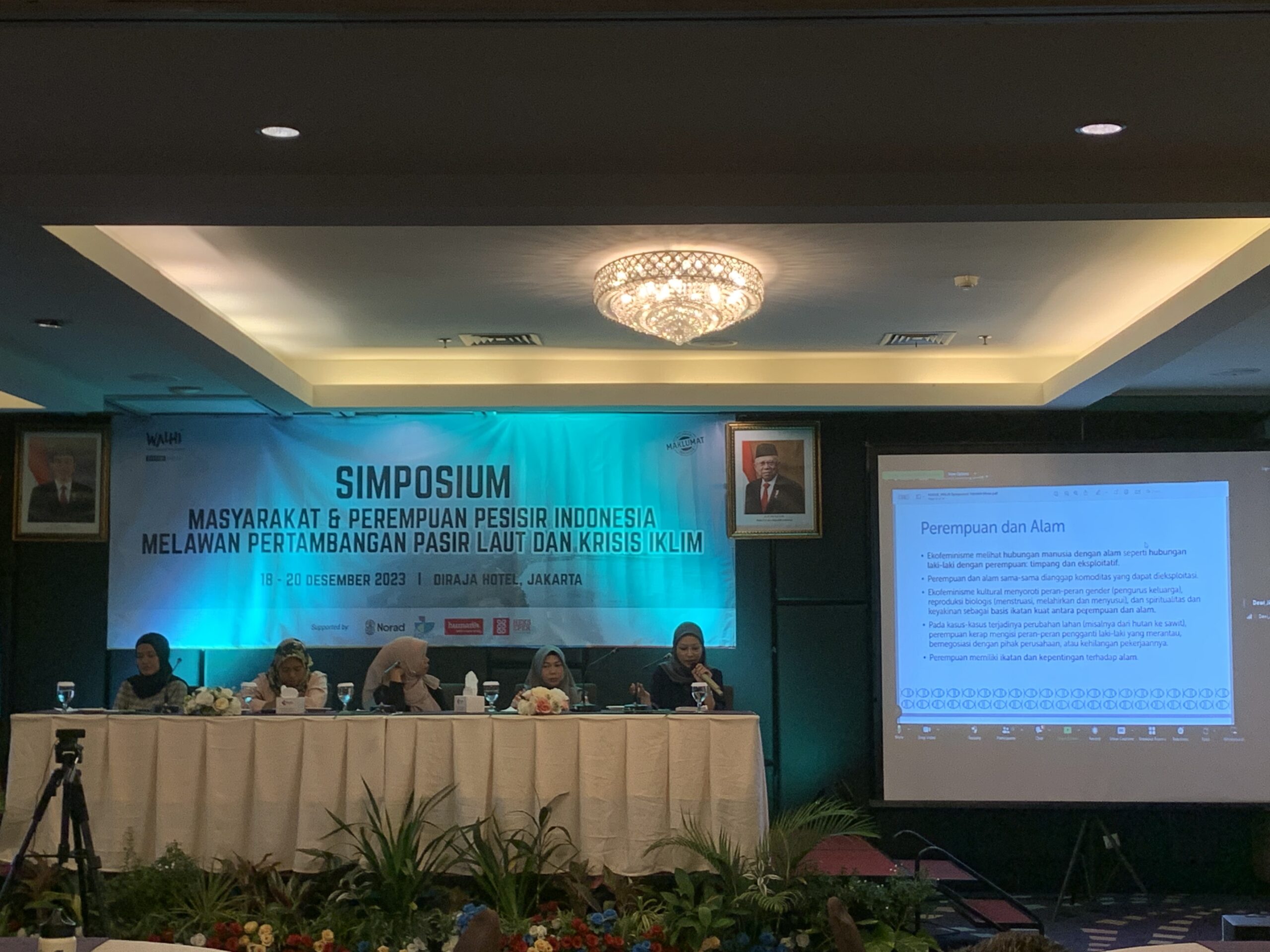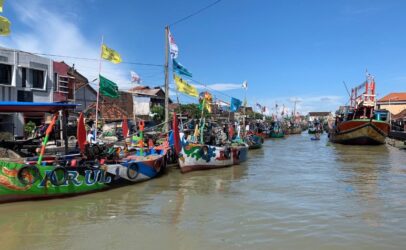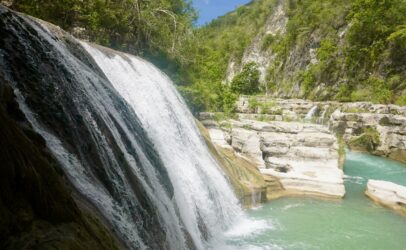Author: Karunia Haganta
Editors: Fadilla D Putri, Nisrina Nadhifah
Disclaimer: Names mentioned in this article are disclosed only by their initials for security reasons

Under the jargon of “World Maritime Axis” Joko Widodo’s administration, in its nearly decade-long tenure, has failed to enhance the well-being of the maritime frontline—the coastal and small islands communities. Instead, a slew of regulations has been enacted to their detriment. These regulations span various levels, encompassing laws, government regulations, presidential decrees, and ministerial orders. Ironically, while the government professes concern for the impacts of the climate crisis, coastal communities and small islands, on the frontline of these challenges, find themselves bearing the brunt. The government’s assertions appear to diverge sharply from the reality on the ground, where these communities grapple with harmful regulations and heightened vulnerability in the face of the climate crisis. Notably, marginalized groups such as women and young people bear the increasingly burdensome weight of layered marginalization in this complex landscape.
This underscores the imperative behind convening the “Symposium of Indonesian Women and Coastal Communities Against Sea Sand Mining and Climate Crisis.” Hosted by Wahana Lingkungan Hidup Indonesia (WALHI) as part of the FOCUS consortium, the symposium took place from December 18 to 20, 2023, in Jakarta. The event drew participation from representatives of 11 WALHI Regional Executives and representatives from coastal communities, including women and youth, hailing from Sumatra, Java, Bali, NTB, and North Maluku. This symposium served as a critical platform for fostering dialogue and collaboration to address the pressing issues related to sea sand mining and the escalating climate crisis affecting these communities.
This symposium placed a spotlight on the critical issue of sea sand mining, prompted by the enactment of Government Regulation (PP) Number 26 of 2023 concerning the Management of Sedimentation Results in the Sea. Remarkably, this regulation is just one among several that adversely impact coastal communities. Noteworthy among these are the Job Creation Law, the Law on the Protection and Empowerment of Fishers, Fish Cultivators, and Farmers, Minister of Maritime Affairs and Fisheries Regulation Number 18 of 2021 concerning the Placement of Fishing Gear and Fishing Aids in the State Fisheries Management Area of the Republic of Indonesia and the High Seas and the Arrangement of Fishing Andons, Minister of Maritime Affairs and Fisheries Regulation Number 33 of 2023 concerning the Implementation Regulations of Government Regulation Number 26 of 2023 concerning the Management of Sedimentation Results in the Sea, and Minister of Maritime Affairs and Fisheries Regulation Number 31 of 2020 concerning the Management of Conservation Areas. These regulations identified as potential threats to the livelihoods of coastal.
Despite the seemingly neutral or community-oriented names or titles of these regulations, their actual content and implementation reveal a different narrative, one that legitimizes exploitative actions by both the government and corporations against coastal communities and small islands. Dedi S. Adhuri, a Senior Researcher at BRIN, highlighted the vulnerability of Government Regulation (PP) on the Management of Sedimentation Results in the Sea, pointing out its potential to legitimize marine grabbing. The utilization of the term “marine sedimentation” as a resource can be manipulated to endorse exploitative practices, particularly through activities like marine sand mining. Representatives of residents, supported by Walhi from various regions such as Riau Islands, Bengkulu, Lampung, and Lombok, NTB, voiced their concerns about this impending threat. A resident from Lombok and another from Riau, identified as U, emphasized that sea sand mining poses a significant risk to coastal areas, particularly jeopardizing fisherfolk’s territories and sandbanks crucial as wave breakers.
This injustice extends beyond the realm of regulations into the domain of planning. Fikerman Saragih, Deputy for Knowledge Management at KIARA, in collaboration with Parid Ridwanuddin, Walhi’s National Executive Marine and Coastal Campaign Manager, presented research on the RZWP3K (Coastal Zone and Small Islands Zoning Plan) across 28 provinces in Indonesia. Their findings underscored a stark marginalization of mangroves and fisherfolk within the RZWP3K framework, where no designated space is allocated for fisherfolk or mangrove. This disparity becomes glaringly evident when comparing the allocated space for fisherfolk and mangroves, a mere 53,712.81 hectares, to the expansive allocation for extractive industries, including reclamation and sea sand mining, which amounts to a staggering 3,590,883.22 hectares. This skewed allocation exacerbates the marginalization of vital ecological elements, emphasizing a prioritization of extractive industries over the preservation of critical ecosystems and the livelihoods of coastal communities.
The intrusion of extractive industries compounds the marginalization experienced by coastal women, adding an extra layer to their struggles. S, a fisherwoman from Kodingareng, South Sulawesi, shared her account of a sea sand mining company that inflicted harm upon her community. Despite the cessation of its activities, lingering impacts such as abrasion and murky water persist. The company’s closure followed a history of community protests met with violence, as resistance was perceived as detrimental to the company’s interests. Similarly, Z, a fisherwoman from Seluma, Bengkulu, recounted a decade-long conflict with a sea sand mining operation, marked by violent responses to community protests, including police deployment resulting in the traumatization of a child and the detention of nine individuals through criminalization.
Both narratives highlight the tangible existence of fisherwomen intricately entwined with movements against injustice. A from Pari Island, Kepulauan Seribu, Jakarta, echoes this sentiment, as she finds herself involved in legal action against a company in a Swiss court. The people of Pari Island confront not only the imminent threat of the climate crisis but also the looming specter of island privatization, revealing the multifaceted challenges faced by these resilient fisherwomen.
“70% of Kodingareng residents have migrated, they are in debt to survive, and don’t know how to pay. More and more children are dropping out of school because their parents can’t afford to pay.” – S, Kodingareng Island, South Sulawesi
The intimate engagement of fisherwomen in the movements, as emphasized by Fadilla, GESI Specialist FOCUS, stands as compelling evidence demanding the acknowledgment of fisherwomen’s existence. Thus far, the labor of fisherwomen has been often perceived merely as “assistance,” resulting in inadequate recognition. However, their active involvement positions them as critical stakeholders, often the most profoundly impacted by detrimental policies and the escalating climate crisis. The multi-layered marginalization experienced by coastal communities, coupled with the pressing challenges posed by the climate crisis, has the potential to fuel gender-based violence against women and contribute to a surge in the number of school dropouts, underscoring the urgent need for a more comprehensive understanding and recognition of the pivotal role played by fisherwomen.
For coastal and small island communities overall, and especially for fisherfolk, the ecological crisis manifests as a multidimensional challenge with far-reaching consequences. While the climate crisis stands as a significant threat, it is not the sole peril. B from Pari Island highlighted that the community on Pari Island is already grappling with the dire consequences of the climate crisis, prompting residents to adapt by transitioning their livelihoods towards plantations. Remarkably, mangroves, which play a crucial role as a protective barrier for the island, are also recognized as an essential economic resource for the community. This underscores the interconnectedness of ecological elements, where the preservation of mangroves is not only vital for environmental resilience but also integral to the economic sustenance of the island’s inhabitants.
Rempang, Riau Islands, while currently less impacted by the climate crisis, faces a looming threat from the Eco City project. According to accounts from N and M, this project poses a serious risk to approximately 17,000 hectares of mangroves and endangers the livelihoods of the residents of Rempang. Meanwhile, in Semarang, both the climate crisis and a development project are unfolding simultaneously. M notes the erosion of the Semarang coast, with mangrove protection nearly eradicated. This situation is further aggravated by the National Strategic Project (PSN) Semarang Demak Sea Wall, despite several villages already being submerged. In Bali, A reveals that residents are compelled to defend areas previously designated for conservation, now threatened by the misuse of authority to alter zoning for a liquefied natural gas (LNG) terminal. Another imminent danger involves a project that similarly jeopardizes mangroves, underscoring the multifaceted challenges faced by these coastal regions.
Coastal and small island communities are resolutely taking action. During the Symposium’s second day, community members actively participated in Focus Group Discussions (FGDs), contributing to the formulation of current and future initiatives. B from Pari Island outlined a series of steps undertaken, including planting initiatives, community deliberations, educational campaigns about the climate crisis, and economic fortification through gardening and the sustainable utilization of mangroves. He emphasized the acknowledgment that resistance incurs its own “costs.” In Central Bangka, J shared that the community-initiated hearings at the district/city level concerning the nuclear power plant project and tin mining, with plans to escalate these discussions to the provincial level given the authority over the 0–12-mile sea. Recognizing the potential harm to fishermen’s fishing grounds and stopover areas, this proactive approach is crucial to safeguard the interests of these communities. In Riau, U, and in Semarang, M, are actively mobilizing strength through networks like KUB (Kelompok Usaha Bersama) and community leaders. In Seluma, Bengkulu, R highlighted advocacy efforts conducted through Walhi directed towards the Public Works and Watershed Agency, addressing the worsening abrasion and its encroachment into residential areas. These collective actions underscore the resilience and determination of coastal communities to confront and mitigate the challenges they face.
In Kodingareng and Lombok, communities find themselves grappling with corporate entities. E, serving as a facilitator in Pasir Besi, Lombok, disclosed that the community’s movement was orchestrated through GARAP NTB. They successfully exposed the issue of company licenses and associated losses amounting to Rp30.6 billion, as calculated by the community. Beyond legal avenues, Kodingareng took a more direct approach, resorting to actions such as bombing company ships. Meanwhile, in East Lampung, S recounted instances of burning barges due to the absence of a viable reporting channel, despite the unity of residents from 11 villages. The community, feeling neglected by law enforcement, questioned their impartiality. S from East Lampung detailed a case where the community fell victim to deception by a sea sand mining project initially presented as river normalization, resulting in criminalization of community protests. Similar unrest emerged in Rempang, leading the community, in collaboration with LBH, to establish eight legal aid posts with representatives from eight villages. The initiative extends its outreach by inviting representatives from other villages to collectively address and counteract the challenges posed by corporate activities.
The compilation of these challenges has formed the foundation for the creation of the Declaration of Coastal Communities and Women Restoring Indonesia and Demanding Climate Justice. This declaration encapsulates 17 key issues that succinctly represent the concerns voiced by coastal communities and small islands regarding climate injustice, policies, and corporate activities. Also, the declaration presents 10 demands directed at the central and local governments, the legislature, and presidential candidates. These ten points call for affirmative measures to be taken in support of coastal and small island communities, encompassing women and young people, while also urging corrective actions against regulations that adversely affect these communities. To access the full content of the declaration, follow this link.







